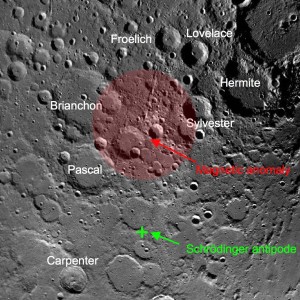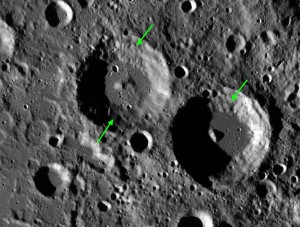The Moon’s Antipodal Magnetism Mystery
A magnetic anomaly near the Moon’s north pole may be related to an impact basin near its south pole. How can this happen?

North polar area showing location of the Schrödinger basin antipode, magnetized area and grooved terrain in Froelich and Lovelace.
Although the Moon has no global magnetic field like the Earth, small areas on its surface are magnetized. These fields are not systematically distributed and in general are very weak. In trying to explain their mysterious presence and origin, several ideas have been advanced.
Rocks typically acquire magnetism (called remnant magnetism) by cooling in the presence of a magnetic field. At temperatures greater than about 570° C (the so-called Curie point), a rock cannot retain a magnetic signature. But if it cools below the Curie point, it assumes an induced magnetic field oriented in the same direction as the field in which it cooled. Unfortunately, on the Moon most rocks have been dislodged from their original orientations by impact processes, so we do not know whether a given rock cooled in the presence of a global (presumably uniform strength and direction) or local (randomized) magnetic field.
We knew the Moon had no global magnetic field before the Apollo crews landed, so it was a bit surprising to learn that some of the returned lunar rocks are strongly magnetized. Because these rocks are all very old (usually much older than 3 billion years), it was thought that they recorded an ancient epoch when the Moon might have had a global magnetic field, now vanished for some reason.
This finding from the lunar samples was complemented by measurements from orbit that show small areas (10s to 100s of kilometers across) of the surface to be magnetized. These areas occur all over the Moon and are not associated exclusively with either the dark volcanic maria or the bright highlands crust. However, they do tend to have two peculiar properties. First, we find strange “grooved” terrain associated with some of the strongest magnetic anomalies. This terrain is unlike any other lunar landform – it consists of ridges and valleys that cover the walls and sides of craters and mountains. Second, these magnetic anomalies tend to occur at the antipodes of (180° away on the opposite side of the globe from) the largest and youngest lunar multi-ring impact basins. These are curious properties indeed. What might it mean?
For years, many have pondered and worked on this dilemma. One idea was developed that perhaps these magnetic anomalies are formed during basin impact. It was proposed that seismic shaking from these enormous impacts created the grooved terrain and induced fractures in the crust at the antipode, into which hot volcanic magma was injected. After cooling these dikes assumed remnant magnetism from a global dipole field. Yet another idea contends that the concentration of magnetized material is a result of antipodal convergence of basin ejecta, which arrived hot from basin formation, collected at the antipode and cooled through the Curie point there. This last model has the advantage that it might also explain the presence of the grooved terrain, which might have formed by the arrival of basin ejecta on the surface from impacts coming from all directions simultaneously.
My colleague Lon Hood from the University of Arizona has been studying magnetic anomalies for many years and is an advocate of the last model described above. Hood was studying some previously ignored, smaller magnetic anomalies found around the Moon that had no explanation. He asked me about the geological setting of one particular magnetic anomaly on the Moon that had yet to be described in detail. This one occurs in highlands near the north pole of the Moon and had not been previously studied in detail.
I have been something of a skeptic for many years about the basin/antipode relation for magnetic anomalies. Part of the reason for my position is the problem of Reiner Gamma, which is a bright patch on the lunar surface that has one of the highest magnetic field strengths on the Moon. The problem is that Reiner Gamma is nowhere near the antipode of any basin and shows no evidence for any grooved terrain. So I thought that this was the exception that disproves the rule.
Nonetheless, I was intrigued by Hood’s finding and decided to examine the area. To my astonishment, I found wall textures very similar to the famous grooved terrain in the walls of the craters Lovelace and Froelich (not exactly coincident with the anomaly, but very close). I can see no obvious reason for such terrain development; it appears to be highly restricted in its distribution and is not a fresh feature. Judging from its degraded appearance, it is rather old.
So, is there a basin antipodal to Lovelace and Froelich? Indeed there is – the fabulous Schrödinger basin, one of the smaller lunar basins at 325 km diameter, located near the south pole of the Moon. Before our study, I probably would have thought that Schrödinger was too small to create any global-scale effects, but we don’t fully understand the effects of impact with increasing size and there is no good alternative explanation for the wall textures of these two craters. The presence of a significant magnetic anomaly nearby is unquestionable.
So have I changed my mind on the origin of lunar magnetic anomalies? Possibly. One of the most convincing ways to get a scientist to change his mind is to bludgeon him with an irrefutable fact that contradicts his worldview. I now realize the Reiner Gamma problem does not “disprove” the basin antipode model – it merely indicates that it may be incomplete. That distinction is subtle but significant. In science, we always look for “rules,” generalities that help us organize observations and suggest possible explanations. However, these rules sometimes have exceptions and we must carefully distinguish which actually have the force of a rule versus those that merely indicate some general tendencies.
To me, this discovery was surprising. The new finding still does not fully address exactly how these magnetic anomalies are formed at the antipodes, but the concept that magnetic anomalies and basin-forming impacts are intimately associated has been strengthened and extended. We will continue to work on this vexing problem.
/https://tf-cmsv2-smithsonianmag-media.s3.amazonaws.com/accounts/headshot/blog_headshot_spudis-300x300.jpg)

/https://tf-cmsv2-smithsonianmag-media.s3.amazonaws.com/accounts/headshot/blog_headshot_spudis-300x300.jpg)